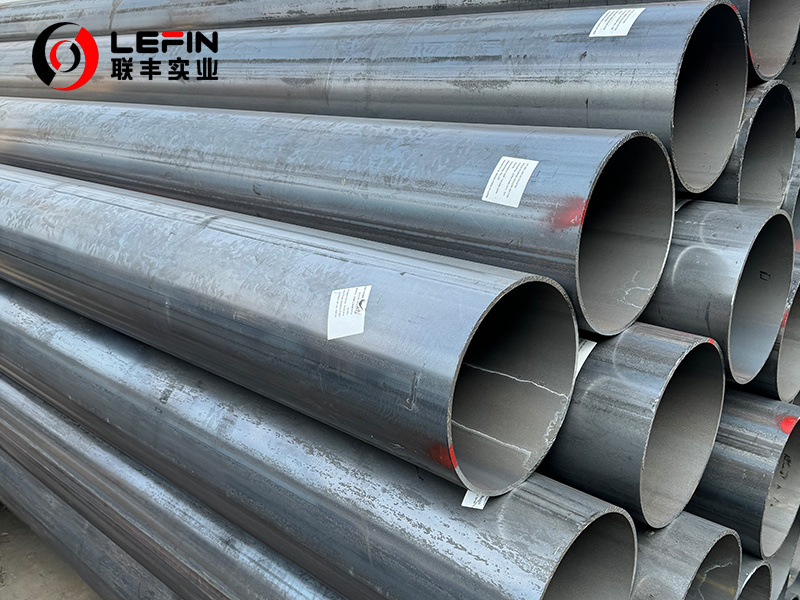

- Details
-
Products Description
1. Core Standard: ASTM A36
Scope: Covers carbon steel plates, shapes, and bars for structural applications (bridges, buildings).
Key Properties:
Min. Yield Strength: 250 MPa (36 ksi)
Min. Tensile Strength: 400–550 MPa (58–80 ksi)
Elongation: 20–23% (based on specimen size).
Chemistry (Max %):
Carbon: 0.26%
Manganese: 0.60–0.90%
Phosphorus/Sulfur: ≤0.04% each
(Iron makes up the balance).
2. HRC Hollow Section: Definition
HRC: Stands for Hot Rolled Commercial quality, Cold-formed.
Form: Hollow structural sections (HSS) created by cold-forming flat-rolled steel (hot-rolled coil) into circular, square, or rectangular tubes.
Manufacturing Process:
Hot-rolled steel coils are unrolled.
Cold-formed into shape via roll forming or press braking.
Welded longitudinally (seam welded).
Sizing/finishing to final dimensions.
3. Mechanical & Chemical Properties
Strength: Matches ASTM A36 requirements:
Yield: ≥250 MPa | Tensile: 400–550 MPa.
Ductility: Suitable for bending/welding.
Chemistry: Similar to plates/bars but optimized for formability. Low carbon ensures weldability.
4. Sizes & Tolerances
Shapes: Square (SHS), Rectangular (RHS), Round (CHS).
Size Range:
Square: OD:20MM×20MM--1200MM×1200MM WT:1.2-60MM
Rectangular: OD:20MM×30MM--1200MM×1500MM WT:1.2-60MM
Circular: ERW:1/2 inch-24inch
LSAW:406MM-1420MM
SSAW:219MM-4020MM
SMLS:1/2inch-1060MM
Tolerances: Governed by ASTM A1085 or A500 for dimensions, straightness, and squareness.
5. Key Distinctions & Misconceptions
HRC ≠ ERW:
ERW (Electric Resistance Welded) is the process used to weld the seam.
HRC refers to the hot-rolled coil base material.
"HRC" vs. Hardness (Rockwell C):
Confusion Alert: "HRC" here ≠ Rockwell hardness scale.
A36 vs. A500/A1085:
A36: Material standard (chemistry/strength).
A500/A1085: Product standards for HSS (tolerances/testing).
A36 HRC HSS follows A36 material properties but uses A500/A1085 for fabrication.
6. Applications
Structural Frames: Beams, columns in buildings.
Support Structures: Racks, frames, conveyors.
Architectural: Railings, furniture, aesthetic elements.
Machinery: Frames, guards, equipment bases.

7. Advantages of A36 HRC HSS
Cost-Effective: Cheaper than alloy steels.
Weldability: Low carbon content prevents cracking.
Formability: Easily cut, drilled, welded.
Availability: Widely stocked globally.
8. Limitations & Considerations
Corrosion: Not corrosion-resistant; requires painting/galvanizing.
Strength Limits: Not suitable for high-stress applications (e.g., offshore).
Cold-Forming Effects: Work hardening may cause slight property variations near corners.
9. Certification & Testing
Mill Certs: Ensure traceability to A36/A500/A1085.
Key Tests:
Tensile strength, yield strength, elongation.
Bend tests (for ductility).
Hydrostatic or ultrasonic weld tests.
10. Practical Guidance
Design Tip: Optimize by considering A1085 (better tolerances/yield strength).
Sourcing: Specify both material (A36) and shape standard (A500 or A1085).
Replacement: A500 Gr C or A1085 offer higher strengths if needed.
Summary:
ASTM A36 HRC Hollow Section combines the cost-effectiveness of mild carbon steel with the versatility of cold-formed HSS. It's ideal for structural applications needing straightforward fabrication and welding. Always confirm your supplier's interpretation of "HRC" and request compliance with ASTM A500 or A1085 for seamless integration into designs. For higher performance, explore A1085-compliant sections.
ASTM A36 HRC HOLLOW SECTION
Subcategory
Keyword
- Details
-
Products Description
1. Core Standard: ASTM A36
Scope: Covers carbon steel plates, shapes, and bars for structural applications (bridges, buildings).
Key Properties:
Min. Yield Strength: 250 MPa (36 ksi)
Min. Tensile Strength: 400–550 MPa (58–80 ksi)
Elongation: 20–23% (based on specimen size).
Chemistry (Max %):
Carbon: 0.26%
Manganese: 0.60–0.90%
Phosphorus/Sulfur: ≤0.04% each
(Iron makes up the balance).
2. HRC Hollow Section: Definition
HRC: Stands for Hot Rolled Commercial quality, Cold-formed.
Form: Hollow structural sections (HSS) created by cold-forming flat-rolled steel (hot-rolled coil) into circular, square, or rectangular tubes.
Manufacturing Process:
Hot-rolled steel coils are unrolled.
Cold-formed into shape via roll forming or press braking.
Welded longitudinally (seam welded).
Sizing/finishing to final dimensions.
3. Mechanical & Chemical Properties
Strength: Matches ASTM A36 requirements:
Yield: ≥250 MPa | Tensile: 400–550 MPa.
Ductility: Suitable for bending/welding.
Chemistry: Similar to plates/bars but optimized for formability. Low carbon ensures weldability.
4. Sizes & Tolerances
Shapes: Square (SHS), Rectangular (RHS), Round (CHS).
Size Range:
Square: OD:20MM×20MM--1200MM×1200MM WT:1.2-60MM
Rectangular: OD:20MM×30MM--1200MM×1500MM WT:1.2-60MM
Circular: ERW:1/2 inch-24inch
LSAW:406MM-1420MM
SSAW:219MM-4020MM
SMLS:1/2inch-1060MM
Tolerances: Governed by ASTM A1085 or A500 for dimensions, straightness, and squareness.
5. Key Distinctions & Misconceptions
HRC ≠ ERW:
ERW (Electric Resistance Welded) is the process used to weld the seam.
HRC refers to the hot-rolled coil base material.
"HRC" vs. Hardness (Rockwell C):
Confusion Alert: "HRC" here ≠ Rockwell hardness scale.
A36 vs. A500/A1085:
A36: Material standard (chemistry/strength).
A500/A1085: Product standards for HSS (tolerances/testing).
A36 HRC HSS follows A36 material properties but uses A500/A1085 for fabrication.
6. Applications
Structural Frames: Beams, columns in buildings.
Support Structures: Racks, frames, conveyors.
Architectural: Railings, furniture, aesthetic elements.
Machinery: Frames, guards, equipment bases.

7. Advantages of A36 HRC HSS
Cost-Effective: Cheaper than alloy steels.
Weldability: Low carbon content prevents cracking.
Formability: Easily cut, drilled, welded.
Availability: Widely stocked globally.
8. Limitations & Considerations
Corrosion: Not corrosion-resistant; requires painting/galvanizing.
Strength Limits: Not suitable for high-stress applications (e.g., offshore).
Cold-Forming Effects: Work hardening may cause slight property variations near corners.
9. Certification & Testing
Mill Certs: Ensure traceability to A36/A500/A1085.
Key Tests:
Tensile strength, yield strength, elongation.
Bend tests (for ductility).
Hydrostatic or ultrasonic weld tests.
10. Practical Guidance
Design Tip: Optimize by considering A1085 (better tolerances/yield strength).
Sourcing: Specify both material (A36) and shape standard (A500 or A1085).
Replacement: A500 Gr C or A1085 offer higher strengths if needed.
Summary:
ASTM A36 HRC Hollow Section combines the cost-effectiveness of mild carbon steel with the versatility of cold-formed HSS. It's ideal for structural applications needing straightforward fabrication and welding. Always confirm your supplier's interpretation of "HRC" and request compliance with ASTM A500 or A1085 for seamless integration into designs. For higher performance, explore A1085-compliant sections.
Related products
Product Consulting

Address: Hengtai Road,Daqiuzhuang Town,Jinghai County,Tianjin,China
Mob: +8615122229899(whatspp)
Phone: +86 22 58171905
Fax: +86 22 58171902
E-mail:info@lefinsteel.com
Get company updates

Tianjin Lefin Industrial Co.,Ltd. All rights reserved City sub-station SEO www.300.cn

